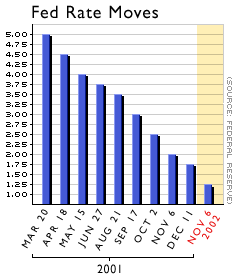NEW YORK (CNN/Money) -
What a difference a month makes -- in November, the financial world waited with bated breath for the outcome of a Federal Reserve policy meeting and then swooned when the central bank, citing a "soft spot" in the U.S. economy, slashed interest rates.
This month, the Fed is likely to do nothing and say little -- and that's probably a good thing.
Fed policy makers are widely expected to leave their target for the federal funds rate -- an overnight lending rate that banks use to form prime lending rates -- unchanged at a 40-year low of 1.25 percent.

What's more, policy-makers are unlikely to change the wording of the policy statement that announces their decision.
At their November meeting, they surprised most observers by slashing a half-percentage-point from rates -- an indication of real worry about future economic weakness -- and then curiously declared that the risks to the economy were balanced between a risk of weakness and one of inflation.
The somewhat schizophrenic move was widely interpreted as a message that the Fed was done cutting rates, at least in the near term.
Only a month has passed since that decision and, while some economic data since then have been painful -- especially the report on November unemployment -- it seems unlikely that the Fed's view of an economy in a short-term soft spot has changed.
"The Fed will sit on its hands," said Diane Swonk, chief economist at Bank One. "There's really no reason to do otherwise. The economy's falling into place as the Fed thought -- it's in a soft spot, with some light at the end of the tunnel."
Swonk pointed out that the recent purge of Treasury Secretary Paul O'Neill and chief White House economic adviser Lawrence Lindsey from President Bush's economic team was even more reason for the Fed not to further shock the economy by making any unexpected moves.
Unexpected moves were the hallmark of the Fed's activities in 2001, when it made 11 rate cuts -- the most ever in a calendar year -- to fight the effects of a recession that began in March of that year, according to the National Bureau of Economic Research.
Three of those cuts, including one cut made shortly after the Sept. 11 terrorist attacks, were made between meetings, when markets weren't expecting them, in an effort to goose the confidence of businesses, investors and individuals.
With interest rates now at rock bottom, the Fed likely will want to hang on to whatever leverage it has left, in case the "geopolitical uncertainties" it's always talking about turn into unpleasant realities. If a war in Iraq drags on for longer than expected, for example, or if terrorists strike again, it wants to be able to cut rates dramatically to boost confidence.
"At this point, they have very little ammo left, and they will need to tread carefully," said Brown Brothers Harriman economist Lara Rhame, a former Fed economist.
The Fed cuts rates to lower the cost of borrowing, which hopefully will put more easy cash in the hands of consumers, whose spending fuels more than two-thirds of the total economy.
| Related stories
|

|
|
|
|
But the Fed reported last week that a key measure of household net worth fell in the third quarter of 2002 to its lowest level in seven years, as household assets dropped 3.4 percent and debts rose 2.2 percent.
With that in mind, does the Fed really want to make borrowing even easier?
"What the Fed has done in the past two years has driven us deeper into debt," said Northern Trust economist Paul Kasriel, "and since I think that is one of the issues ailing the economy now, I don't see going deeper into debt as a cure."
A better remedy might come from Congress, which will soon get to chew on a big, fat economic stimulus plan from President Bush and his new economic team.
And the size and scope of such a package will be yet another reason for the Fed to sit on the sidelines. Though some economists are worried about the risk of deflation, or falling prices, now, the Fed likely will be reluctant to risk fueling future runaway inflation by slashing rates at the same time Congress has its own firehose pumping money into the economy.
"[Fed policy-makers] think their job now is to play a supporting role," Kasriel said. "They kind of want to drift into the background."

|

